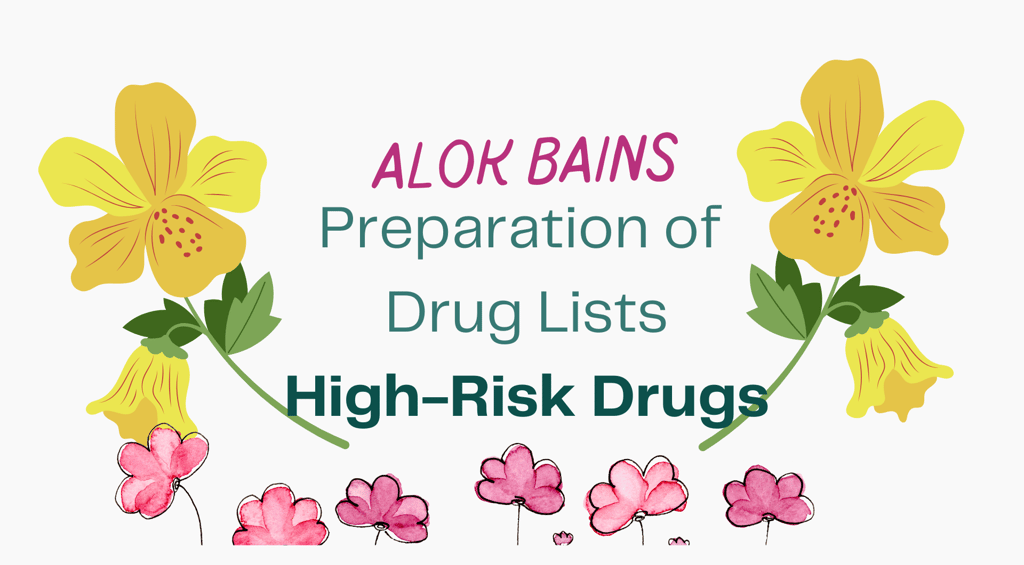High Risk Drugs
Preparation of Drug List of High-Risk Drugs.
HOSPITAL PHARMACY
Alok Bains
4/21/20233 min read


Preparation of drug lists
High-Risk Drugs or High-Alert Drugs
Compiled by: ALOK Singh
Modern healthcare delivery systems are a boon for human health. But it is often associated with inevitable harm to patients. Adverse events are the 14th leading reason for human morbidity and mortality. It is mainly due to unsafe health care that also reduces efficiency, increases cost and compromise health outcome and patient perception. The most important challenge is to prevent patient harm. World Health Organization (WHO) launched the first Global Patient Safety Challenge: Clean Care is Safer Care in 2005 followed by the second challenge: Safe Surgery Save Lives. In 2017 and the third Global Safety Challenge: Medication Without Harm was launched. WHO asked stakeholders to protect patients from harm by adopting the following three strategies.
Medication safety in a high-risk situation,
Medication safety in polypharmacy,
Medication safety in the transition of care.
High-Risk Drugs List
Normally, Medicines with low therapeutic index are High Risk (High Alert) Drugs. "High-Risk Drugs have a heightened risk to cause significant patient harm if they are used in error" Mistakes may or may not happen. But it will be more devastating to patients. Thus it will be better to alert medical professionals by developing a high-risk drug list. The key step to ensure patent safety in all conditions is the preparation of a high-risk (High-alert) drug list. It is prepared by considering the followings:
Risk assessment of the drug,
Medication review,
Dispensing, Preparation and administration review,
Patient engagement, and
Medication reconciliation at care transition.
Medications, prescribers, pharmacists, nurses, work environment, and patients are contributors to causing patient harm during the health care of patients. Multidisciplinary Committee consist of these members preparing high-Risk drug list. It is better to develop this list at the local level by health care professionals. And it should be regularly updated.
They focus on particular risks at their own workplace. Thus, the High-Risk Drug list varies from country to country and place to place due to variations in care settings, disease epidemiology, adverse drug events and medication error. They follow the following steps to prepare A High-Risk drug list to improve medication safety in high-risk situations and reduce harm.
Identification of drugs: A group of physicians, nurses, pharmacists, patients, regulators, and health system leaders select and prioritize a small number of high-risk (high-alert) medications.
Plan development: They develop a plan to identify drugs by educating and training health care professionals and patients. They decide the process and system to identify High-Risk Drugs.
Sustainable strategy development: They address each of the priority areas in medication safety identified by the country. Medication errors are often caused by a combination of medication, prescribers and patient, and systems factors.
Development of a strong safety culture within health care.
Establishment of systems for reporting medication errors at the national and institutional levels.
However, some High-Risk Drugs have been identified globally. Inappropriate use of many medicines or their use with errors may produce significant harm to patients. Some classes of drugs have been proven globally HighRisk Drugs. This list can be recalled by using the mnemonic “A PINCH”. Examples of some medications frequently classified as High-Risk Drugs under "A PINCH" are the following.
A: Anti-infective: Amphotericin Aminoglycosides (amikacin, gentamicin, streptomycin and tobramycin) and the glycopeptide antibiotic, etc.
P: Potassium and other electrolytes Injections of potassium, magnesium, calcium, hypertonic sodium chloride
I: Insulin: All insulins
N: Narcotics (opioids) and other sedatives: Oxycodone, morphine Fentanyl, etc and analgesic patches Benzodiazepines such as diazepam, midazolam Thiopentone, propofol and other short-term anaesthetics.
C: Chemotherapeutic and immunosuppressive agents: Vincristine Methotrexate, Azathioprine, etc.
H: Heparin and oral anticoagulants: Warfarin Rivaroxaban, dabigatran, apixaban,etc.
Other High-risk medicines identified at the local health district/facility/unit level do not fit the above categories.
Institute for safe medication practices (ISMP) founded and supported by US FDA developed a High-Risk Drugs list on basis of inputs from practitioners and safety experts. This list includes the following classes/categories of medications:
Adrenergic agonists, IV (e.g., EPINEPHrine, phenylephrine, norepinephrine)
Adrenergic antagonists, IV (e.g., propranolol, metoprolol, labetalol)
Anaesthetic agents, general, inhaled and IV (e.g., propofol, ketamine)
Antiarrhythmics, IV (e.g., lidocaine, amiodarone)
Antithrombotic agents, including anticoagulants (e.g., warfarin, low molecular weight heparin, unfractionated heparin) direct oral anticoagulants and factor Xa inhibitors (e.g., dabigatran, rivaroxaban, apixaban, edoxaban, betrixaban, fondaparinux) direct thrombin inhibitors (e.g., argatroban, bivalirudin, dabigatran) glycoprotein IIb/IIIa inhibitors (e.g., eptifibatide) thrombolytics (e.g., alteplase, reteplase, tenecteplase)
Cardioplegic solutions
Chemotherapeutic agents,
Dextrose, hypertonic, 20% or greater
Dialysis solutions, peritoneal and hemodialysis
Epidural and intrathecal medications
Inotropic medications, IV (e.g., digoxin, milrinone)
Insulin, subcutaneous and IV
Liposomal forms of drugs (e.g., liposomal amphotericin B) and conventional counterparts (e.g., amphotericin B desoxycholate)
Moderate sedatives, IV (e.g., dexmedetomidine, midazolam, LORazepam) moderate and minimal sedation agents, oral, for children (e.g., chloral hydrate, midazolam, ketamine [using the parenteral form])
Opioids, including IV oral (including liquid concentrates, immediate- and sustained-release formulations) transdermal
Neuromuscular blocking agents (e.g., succinylcholine, rocuronium, vecuronium)
Parenteral nutrition preparations
Sodium chloride for injection, hypertonic, greater than 0.9% concentration sterile water for injection, Inhalation and irrigation (excluding pour bottles) in containers of 100 mL or more
Sulfonylurea hypoglycemics, oral (e.g., chlorproPAMIDE, glimepiride, glyBURIDE, glipiZIDE, TOLBUTamide)
Compiled by: ALOK Singh
